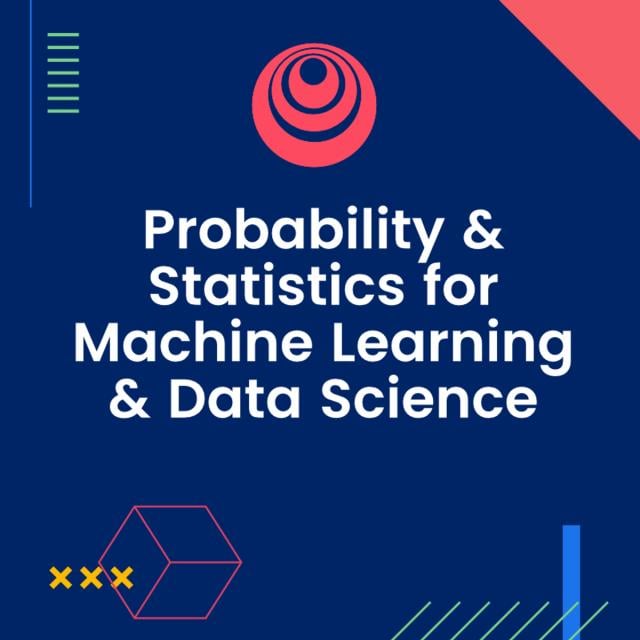MOOC List is learner-supported. When you buy through links on our site, we may earn an affiliate commission.

MOOC List is learner-supported. When you buy through links on our site, we may earn an affiliate commission.
After completing this course, learners will be able to:
• Describe and quantify the uncertainty inherent in predictions made by machine learning models, using the concepts of probability, random variables, and probability distributions.
• Visually and intuitively understand the properties of commonly used probability distributions in machine learning and data science like Bernoulli, Binomial, and Gaussian distributions
• Apply common statistical methods like maximum likelihood estimation (MLE) and maximum a priori estimation (MAP) to machine learning problems
• Assess the performance of machine learning models using interval estimates and margin of errors
• Apply concepts of statistical hypothesis testing to commonly used tests in data science like AB testing
Many machine learning engineers and data scientists struggle with mathematics. Challenging interview questions often hold people back from leveling up in their careers, and even experienced practitioners can feel held by a lack of math skills.
This specialization uses innovative pedagogy in mathematics to help you learn quickly and intuitively, with courses that use easy-to-follow plugins and visualizations to help you see how the math behind machine learning actually works. Upon completion, you’ll understand the mathematics behind all the most common algorithms and data analysis techniques — plus the know-how to incorporate them into your machine learning career.
Course 3 of 3 in the Mathematics for Machine Learning and Data Science Specialization.
What You Will Learn
- Describe and quantify the uncertainty inherent in predictions made by machine learning models
- Visually and intuitively understand the properties of commonly used probability distributions in machine learning and data science
- Apply common statistical methods like maximum likelihood estimation (MLE) and maximum a priori estimation (MAP) to machine learning problems
- Assess the performance of machine learning models using interval estimates and margin of errors
Syllabus
WEEK 1
Week 1 - Introduction to Probability and Probability Distributions
In this week, you will learn about probability of events and various rules of probability to correctly do arithmetic with probabilities. You will learn the concept of conditional probability and the key idea behind Bayes theorem. In lesson 2, we generalize the concept of probability of events to probability distribution over random variables. You will learn about some common probability distributions like the Binomial distribution and the Normal distribution.
WEEK 2
Week 2 - Describing probability distributions and probability distributions with multiple variables
This week you will learn about different measures to describe probability distributions as well as any dataset. These include the measures of central tendency (mean, median, and mode), variance, skewness, and kurtosis. The concept of the expected value of a random variable is introduced to understand each of these measures. You will also learn about some visual tools to describe data and distributions. In lesson 2, you will learn about the probability distribution of two or more random variables using concepts like joint distribution, marginal distribution, and conditional distribution. You will end the week by learning about covariance: a generalization of variance to two or more random variables.
WEEK 3
Week 3 - Sampling and Point estimation
This week shifts its focus from probability and statistics. You will start by learning the concept of a sample and a population and two fundamental results from statistics that concern samples and population: the law of large numbers and the central limit theorem. In lesson 2, you will learn the first and the simplest method of estimation in statistics: point estimation. You will see how maximum likelihood estimation, the most common point estimation method, works and how it connects with regularization (technique used to reduce overfitting in machine learning) using Bayes theorem.
WEEK 4
Week 4 - Confidence Intervals and Hypothesis testing
This week you will learn another estimation method called interval estimation. The most common interval estimates are confidence intervals and you will see how they are calculated and how to correctly interpret them. In lesson 2, we cover the third estimation method called hypothesis testing where estimates are formulated as hypothesis and then tested in the presence of available evidence or sample of data. You will learn the concept of p-value that helps in making a decision for a hypothesis test and also learn some common tests like the t-test, two-sample t-test, and the paired t-test. We end the week with an interesting application of hypothesis testing in data science: A/B testing.
MOOC List is learner-supported. When you buy through links on our site, we may earn an affiliate commission.
MOOC List is learner-supported. When you buy through links on our site, we may earn an affiliate commission.
